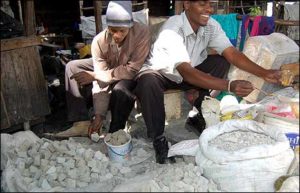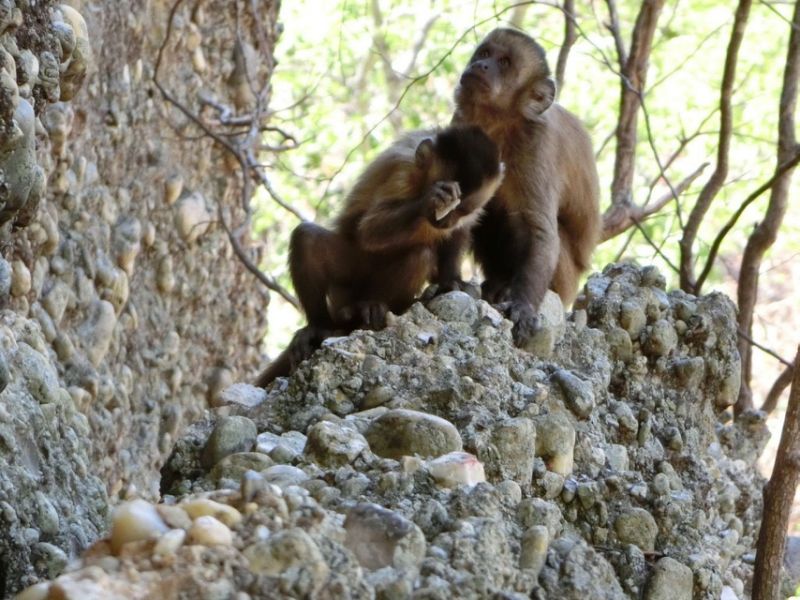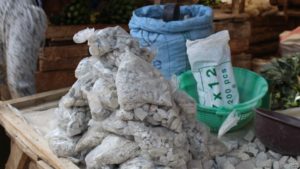Craving Minerals, Eating Rocks: Why do animals and humans eat rock dust?
Last October the Los Angeles Times released an article about research on tool-use among the wild bearded capuchin monkeys of Brazil. The article showcased two short videos of the monkeys smashing rocks against larger boulders – which was interpreted as intentional tool-making behavior.
With a closer look, another strange behavior emerged. The monkeys occasionally licked the rocks in their paws.
Several hypotheses were proposed to explain this behavior: the monkeys were licking off the minerals in the rock dust collected on the surface of the rocks; they were consuming lichen with antimicrobial properties; or, they were simply consuming fragments of rocks that can destroy parasites in their guts.
Aside from the capuchin monkeys, other animals have also been observed to demonstrate geophagy (“soil-eating”), including but not limited to: rodents, birds, elephants, pacas and other species of primates.[1]
Knowing this, Remineralize the Earth is interested in the potential benefits that consumption of rock dust and soil can create. We present this article as a short introduction to the behavior of geophagy in the context of animal and human soil consumption, while also discussing current developments regarding the use of soil and rock dust as health supplements.
Aside from wild monkeys, domestic animals are also known to involuntarily engage in geophagy during the consumption of grass and roots. Research in New Zealand found that sheep ingest more than 75 kg of soils, and dairy cows ingest more than 650 kg of soils in a year. The research contended that soil can be a large source of iodine and cobalt, the latter of which is used to make Vitamin B12[2]. Vitamin B12 is essential to the creation of red blood cells and DNA, as well as to the support of normal neurological function[3].
Perhaps it is these physical and neurological benefits that inspire cultures around the world – particularly those in the tropics – to practice geophagy. Visiting a market in Cameroon or Kenya, one might see store vendors selling soils packed in various shapes and forms, and/or soft stone ‘delicacies’ that consumers can suck on. In Sub-Saharan Africa, it is common to find pregnant women and children consuming soils. So common is this practice that it has been estimated that as much as 84% of pregnant women in some countries practice geophagy[4]. Cited reasons for engaging in geophagy include the ‘pleasant tastes’ of rocks and soils and even addictive cravings[5]. As a testimony to the addictive properties of geophagy, one Kenyan woman engaging in this practice commented to BBC reporters: “I just have this urge to eat these stones. I do very crazy things, I would even wake up at night and go looking for them.” (For more information on rock craving in Sub-Saharan Africa, watch this video). Additionally, ancient art has been uncovered that depicts the habitual consumption of rock powder and clay (Callahan 2000).
Researchers found that the majority of geophagy cases involve the ingestion of clay-based soil, suggesting that the binding properties of clay help absorb toxins. Some clay may also contain aluminum salt, a common component in vaccines, suggesting that the consumption of it may provide additional immunization. This proves especially important in tropical regions where medical access is limited and pathogens are more common [6].
Another hypothesis is that soils contain minerals that serve as nutritional supplements[7],[8]. A study on mountain gorillas discovered that populations in higher altitudes consumed iron-rich soil, the mineral iron being an important component of hemoglobin production. Since hemoglobins bind to oxygen to transport themselves throughout the entire body, additional iron consumption is essential in regions where oxygen is scarcer, for example high altitude locations. Whether the hypothesis can be applied to human soil consumption remains to be tested. However, it gives hopeful evidence that consuming soil does provide essential nutrients, as opposed to it being a futile act of desperation in times of famine1[9].
Some companies have bought into the benefits of geophagy by offering soil-based products claiming health-related benefits. An example of this is Luvos Heilerde (Luvos Healing Earth), a German company founded by Adolf Just in 1918, with the mission to create therapeutic products using loess (a type of windblown sediment). Another example is Excelerite, a Nevada-based corporation that mines rare earth minerals from the caldera basin for remineralization purposes and they sell a product called MicroEXCELERITE as a health supplement. The latter is mined from underground, is even finer and hasn’t been exposed to environmental hazards. Both health supplements offered by Luvos Heilerde and Excelerite come from naturally ground-up rock dust.

Preparing rocks for pregnant women to purchase at markets in Kenya where it is a product sold as odowa (Click to enlarge)
Despite the numerous benefits of geophagy, caution is advised against eating soils on a whim. Indiscriminate consumption of soils from unknown sources can cause effects such as constipation and heavy metal intoxication. These side effects are compounded by unbalanced soil-eating, such as not drinking enough liquid. Alice Ndong, a nutritionist, warned: “If somebody eats those stones and they don’t take enough water, then they will actually get severe constipation…It can actually be very dangerous [and] cause things like kidney damage and liver damage[.]”5
It is therefore imperative to obtain supplements from well trusted sources. This includes many companies which produce soil-based health supplements that have undergone rigorous testing and approval by reliable agencies, proving beneficial effects to the consumer.
Turning back to the video: were these capuchin monkeys engaging in geophagy for a reason? Researchers remain uncertain, but what is determined is that geophagy is part of human culture as well as animal behavior, and that the benefits of clay-consumption have also been promoted by many health supplement companies.
Zu Dienle Tan recently graduated from the University of Michigan with a Master’s degree in natural resources and environment. She specializes in conservation ecology and is passionate about biodiversity conservation, agroecosystems and sustainable development.
References:
[1] Ramanathan, K., and Mahaney, W.C. “Geophagy among primates: Adaptive significance and ecological consequences.” Animal Behavior (2000): 899-915.
[2] Geophagy and the Involuntary Ingestion of Soil. Chapter 17 of Essentials of Medical Geology by Peter W. Abrahams (2013).
[3] “Vitamin B12.” National Institutes of Health. U.S. Department of Health and Human Services, 11 Feb. 2016. Web.
[4] Njiru, H., Elchalal, U., & Paltiel, O. “Geophagy during pregnancy in Africa: a literature review”. Obstetrical & Gynecological Survey (2011): 452-459.
[5] Mawathe, Anne. “Why Kenyan Women Crave Stones.” BBC News. BBC, 18 Sept. 2008. Web.
[6] Ramanujan, Krishna. “Eating Dirt May Protect against Pathogens and Toxins.” Cornell Chronicle. Cornell University, 9 June 2011. Web.
[7] Diamond, J.M. “Evolutionary Biology: Dirty Eating for Healthy Living.” Nature 400 (1999): 120-121.
[8] Gabbatiss, Josh. “The People Who Can’t Stop Eating Dirt.” BBC News. BBC, 16 June 2016. Web.
[9] Callahan, G.N. “Eating Dirt.” Emerging Infectious Disease 9 (2003): 1016-1021.
Support us on Patreon
Thank you for joining us today! Please become a member of RTE and support us on Patreon. Unlike many larger organizations, we work with a team of determined and passionate volunteers to get our message out. We aim to continue to increase the awareness of remineralization to initiate projects across the globe that remineralize soils, grow nutrient dense food, regenerate our forests’ and stabilize the climate – with your help! If you can, please support us on a monthly basis from just $2, rest assured that you are making a big impact every single month in support of our mission. Thank you!











boo
July 4, 2022 (11:00 am)
Returning to nature and letting her heal us thank you for your research.